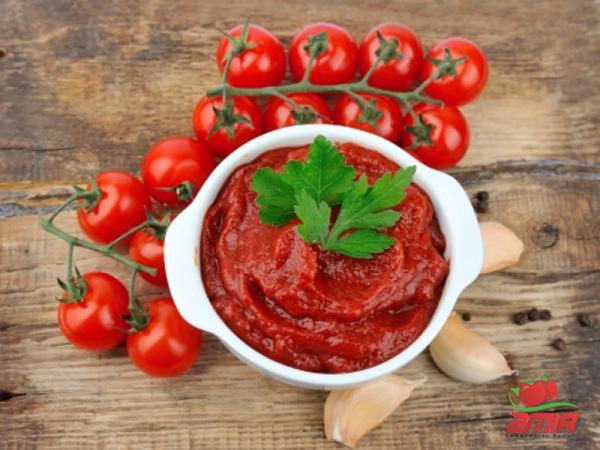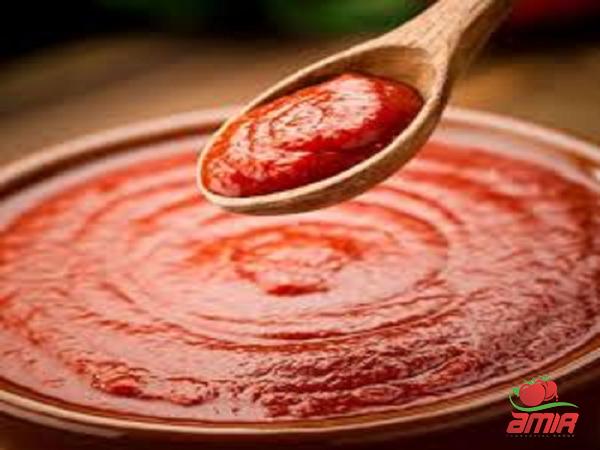A Versatile Ingredient for Savory Delights Introduction: Tomato paste is a concentrated form of tomato puree that is widely used in various cuisines around the world. Known for its rich flavor and vibrant red color, tomato paste serves as a versatile ingredient that enhances the taste of countless dishes. In this article, we will discuss the basics of tomato paste, including its production, factors to consider while buying, and its price range. 1. Discuss Tomato Paste: Tomato paste is the result of reducing ripe tomatoes to a thick, concentrated form. The process involves removing the skin and seeds from the tomatoes, then cooking and simmering them until the desired consistency is achieved. This concentration not only intensifies the flavor but also extends the shelf life of the product, making it convenient for both home cooking and commercial purposes. Tomato paste is generally sold in cans or tubes and can be found in most grocery stores. 2. Buying Tomato Paste: When purchasing tomato paste, there are a few factors to consider to ensure you get the best quality product. Here are some things to keep in mind: a) Ingredients: Check the ingredients list for any additives or preservatives. Some brands may contain added salt, sugar, or other flavoring agents. Opting for a product with minimal or no additives allows for more control over the final taste of your dishes. b) Consistency: Tomato paste is available in various thicknesses, ranging from firm to smooth textures. Depending on your cooking needs, choose a consistency that suits your recipe. Thicker paste works well for hearty stews and sauces, while the smoother variety blends seamlessly in soups or marinades. c) Packaging: While most tomato paste is sold in cans, some brands offer alternative packaging such as tubes or sachets.

tomato paste
 The advantage of tubes is that they allow for easy dispensing and storage, especially when a recipe only demands a small amount of tomato paste. Choosing the right packaging depends on your cooking habits and personal preferences. d) Organic or conventional: Consider whether you prefer organic tomato paste, which is made from tomatoes grown without synthetic pesticides or fertilizers. Organic options are becoming more widely available and offer a choice for those looking for a more sustainably-produced product. 3. Price of Tomato Paste: The price of tomato paste can vary depending on several factors, including brand, quality, packaging size, and country of origin. Generally, supermarket own-brand tomato paste tends to be more affordable compared to premium or specialty brands. However, it’s important to note that quality does play a significant role in the taste and overall satisfaction of the final dish. Higher-priced brands often use premium tomatoes and take extra care in the manufacturing process, leading to a superior product. The price range in local grocery stores can vary from a few dollars for a small can or tube to around $10 for a larger container. The cost of imported tomato paste might be slightly higher due to transportation expenses and import taxes. It’s advisable to compare prices, read product reviews, and consider your budget along with your culinary requirements before making a purchase. Conclusion: Tomato paste is a culinary staple that adds depth and flavor to a wide range of dishes. From homemade pasta sauces to braised meats and stews, tomato paste serves as a versatile ingredient that can elevate your cooking to new heights.
The advantage of tubes is that they allow for easy dispensing and storage, especially when a recipe only demands a small amount of tomato paste. Choosing the right packaging depends on your cooking habits and personal preferences. d) Organic or conventional: Consider whether you prefer organic tomato paste, which is made from tomatoes grown without synthetic pesticides or fertilizers. Organic options are becoming more widely available and offer a choice for those looking for a more sustainably-produced product. 3. Price of Tomato Paste: The price of tomato paste can vary depending on several factors, including brand, quality, packaging size, and country of origin. Generally, supermarket own-brand tomato paste tends to be more affordable compared to premium or specialty brands. However, it’s important to note that quality does play a significant role in the taste and overall satisfaction of the final dish. Higher-priced brands often use premium tomatoes and take extra care in the manufacturing process, leading to a superior product. The price range in local grocery stores can vary from a few dollars for a small can or tube to around $10 for a larger container. The cost of imported tomato paste might be slightly higher due to transportation expenses and import taxes. It’s advisable to compare prices, read product reviews, and consider your budget along with your culinary requirements before making a purchase. Conclusion: Tomato paste is a culinary staple that adds depth and flavor to a wide range of dishes. From homemade pasta sauces to braised meats and stews, tomato paste serves as a versatile ingredient that can elevate your cooking to new heights.
Specifications of tomato paste
 When buying tomato paste, paying attention to the ingredients, consistency, packaging, and price will help you make an informed choice and enjoy the best possible product. So, enhance your culinary creations with the rich taste of tomato paste and let your cooking shine.4. Cooking Tips and Recipe Ideas: Aside from being a foundational ingredient in many recipes, tomato paste can also be used in creative ways to add a burst of flavor to your dishes. Here are some cooking tips and recipe ideas to inspire your culinary adventures: a) Flavor base: Tomato paste can be a great starting point for building a robust flavor base. Sautéing tomato paste with aromatics like onions, garlic, and spices can create a flavorful foundation for soups, stews, and sauces. This technique helps unlock the full potential of the tomato paste and enhances the overall taste of the dish. b) Pasta sauces: Tomato paste forms the base of many classic pasta sauces. Mix tomato paste with garlic, onions, herbs, and olive oil for a simple yet delicious sauce. Alternatively, venture into the world of Italian cuisine by making a hearty Bolognese sauce or a creamy vodka sauce using tomato paste as a key ingredient. c) Marinating: Tomato paste can act as a powerful marinade for meats, poultry, and fish. Combine it with other ingredients such as garlic, vinegar, or soy sauce to create a flavorful coating for grilling, roasting, or pan-frying. The natural acidity in tomato paste helps tenderize the meat and infuses intense flavors. d) Indian curries: Tomato paste is a common ingredient in many Indian curries. Its rich flavor adds depth to dishes like butter chicken, tikka masala, or chana masala. The concentrate and thickness of the paste contribute to the gravy’s texture and make it a popular choice for authentic Indian cuisine. e) Vegetarian dishes: Tomato paste is an excellent option for vegetarian and vegan cooking as it adds depth and umami to plant-based recipes.
When buying tomato paste, paying attention to the ingredients, consistency, packaging, and price will help you make an informed choice and enjoy the best possible product. So, enhance your culinary creations with the rich taste of tomato paste and let your cooking shine.4. Cooking Tips and Recipe Ideas: Aside from being a foundational ingredient in many recipes, tomato paste can also be used in creative ways to add a burst of flavor to your dishes. Here are some cooking tips and recipe ideas to inspire your culinary adventures: a) Flavor base: Tomato paste can be a great starting point for building a robust flavor base. Sautéing tomato paste with aromatics like onions, garlic, and spices can create a flavorful foundation for soups, stews, and sauces. This technique helps unlock the full potential of the tomato paste and enhances the overall taste of the dish. b) Pasta sauces: Tomato paste forms the base of many classic pasta sauces. Mix tomato paste with garlic, onions, herbs, and olive oil for a simple yet delicious sauce. Alternatively, venture into the world of Italian cuisine by making a hearty Bolognese sauce or a creamy vodka sauce using tomato paste as a key ingredient. c) Marinating: Tomato paste can act as a powerful marinade for meats, poultry, and fish. Combine it with other ingredients such as garlic, vinegar, or soy sauce to create a flavorful coating for grilling, roasting, or pan-frying. The natural acidity in tomato paste helps tenderize the meat and infuses intense flavors. d) Indian curries: Tomato paste is a common ingredient in many Indian curries. Its rich flavor adds depth to dishes like butter chicken, tikka masala, or chana masala. The concentrate and thickness of the paste contribute to the gravy’s texture and make it a popular choice for authentic Indian cuisine. e) Vegetarian dishes: Tomato paste is an excellent option for vegetarian and vegan cooking as it adds depth and umami to plant-based recipes.
buy tomato paste
 Try incorporating it in vegetable stews, ratatouille, or homemade veggie burgers to enhance the overall flavor profile. f) Pizza and flatbreads: Tomato paste serves as a delicious base for homemade pizzas and flatbreads. Spread it on the dough, top with your favorite ingredients, and bake until golden and bubbling. The concentrated flavor of tomato paste creates a vibrant and flavorful pizza sauce that will impress your family and friends. 5. Health Benefits of Tomato Paste: Beyond its culinary versatility, tomato paste offers numerous health benefits. Tomatoes are rich in lycopene, a powerful antioxidant known for its potential anti-cancer properties. The concentration process used in tomato paste manufacturing increases the availability of lycopene, making it even more beneficial for our bodies. Lycopene has been linked to reducing the risk of certain cancers, including prostate, lung, and stomach cancer. Additionally, tomatoes are packed with essential vitamins and minerals such as vitamin C, potassium, and folate. Conclusion: Tomato paste is a kitchen staple that adds depth, flavor, and vibrant color to an array of dishes. As an essential ingredient in cuisines worldwide, tomato paste is a versatile addition to your pantry. Whether you use it as a flavor base, a marinade, or a base for pasta sauces, the concentrated flavor of tomato paste is bound to elevate your cooking. By considering the factors when buying—ingredients, consistency, packaging, and price—you can find the perfect tomato paste for your culinary needs. So, embrace the bold flavor of tomato paste and enjoy the endless possibilities it offers in enhancing your savory delights.
Try incorporating it in vegetable stews, ratatouille, or homemade veggie burgers to enhance the overall flavor profile. f) Pizza and flatbreads: Tomato paste serves as a delicious base for homemade pizzas and flatbreads. Spread it on the dough, top with your favorite ingredients, and bake until golden and bubbling. The concentrated flavor of tomato paste creates a vibrant and flavorful pizza sauce that will impress your family and friends. 5. Health Benefits of Tomato Paste: Beyond its culinary versatility, tomato paste offers numerous health benefits. Tomatoes are rich in lycopene, a powerful antioxidant known for its potential anti-cancer properties. The concentration process used in tomato paste manufacturing increases the availability of lycopene, making it even more beneficial for our bodies. Lycopene has been linked to reducing the risk of certain cancers, including prostate, lung, and stomach cancer. Additionally, tomatoes are packed with essential vitamins and minerals such as vitamin C, potassium, and folate. Conclusion: Tomato paste is a kitchen staple that adds depth, flavor, and vibrant color to an array of dishes. As an essential ingredient in cuisines worldwide, tomato paste is a versatile addition to your pantry. Whether you use it as a flavor base, a marinade, or a base for pasta sauces, the concentrated flavor of tomato paste is bound to elevate your cooking. By considering the factors when buying—ingredients, consistency, packaging, and price—you can find the perfect tomato paste for your culinary needs. So, embrace the bold flavor of tomato paste and enjoy the endless possibilities it offers in enhancing your savory delights.










Your comment submitted.